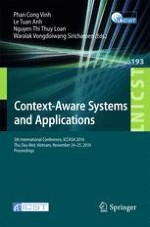2017 | Buch
Context-Aware Systems and Applications
5th International Conference, ICCASA 2016, Thu Dau Mot, Vietnam, November 24-25, 2016, Proceedings
herausgegeben von: Phan Cong Vinh, Le Tuan Anh, Nguyen Thi Thuy Loan, Waralak Vongdoiwang Siricharoen
Verlag: Springer International Publishing
Buchreihe : Lecture Notes of the Institute for Computer Sciences, Social Informatics and Telecommunications Engineering
